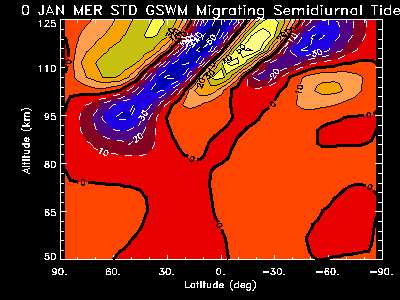
Animation cycles three times (three solar days). [ESC] to stop, Reload to replay.

The meridional semidiurnal tide at solstice is characterized by a series of 4 peaks of alternating direction which reach maximum amplitude at approximately 110km, and which diminish quickly in amplitude below 100-80km. Amplitudes in the winter hemisphere are greater and originate from lower in the atmosphere than in the summer hemisphere.
The tide is not symmetric about the equator in January, rather its pattern is roughly repeated in each hemisphere, with a shift toward the north of about 10 degrees. Its 4 peaks are separated by approximately 30 degrees of latitude.
The phase velocity is downward and to the south, though the tide propagates in the opposite direction, upward and to the north. The vertical wavelength of semidiurnal tides is longer than that of diurnal tides, about 50km here.
The phase velocity of the equinox tide (not shown here) points vertically upward and bends toward the spring pole. The same rough repetition of the tide across hemispheres occurs, though the tide is centered over the equator. No peaks are observed at lower altitudes (below 100km), as they are in the solstice case. The tide's significant activity occurs above 85-90 km.
Contrast with the semidiurnal zonal tide (April case), which is symmetric across the equator, the diurnal meridional tide (January), which shows a shorter vertical wavelength and asymmetry across the equator; or compare with the "top view" of the meridional tide in a latitude vs. longitude view at 100km (April).